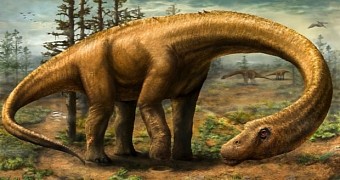In September 2014, Drexel University paleontologists and their colleagues announced the discovery of a previously undocumented dinosaur species.
The beast, named Dreadnoughtus schrani by the team who discovered it, lived about 77 million years ago in South America. Its favorite habitat was dense forests then growing in that corner of the globe.
This dinosaur was way bigger than T. rex
Courtesy of blockbusters like “Jurassic Park,” a lot of people think of the vicious Tyrannosaurus rex as the absolute scariest dinosaur ever to walk the Earth.
The thing is that, as surprising as this may sound, the recently discovered Dreadnoughtus schrani was a far more impressive sight. At least as far as body size goes.
In the report announcing the discovery of this new dinosaur species, researchers put its weight at 65 tons. That's 7 times heavier than a Tyrannosaurus rex.
As for its overall body length, fossil evidence indicates that these ancient creatures measured 26 meters (85 feet) from head to tail. Yup, Dreadnoughtus schrani was positively gargantuan.
Its neck alone was about 11.3 meters (36 feet) long. Further, its tail is said to have measured approximately 9 meters (roughly 30 feet) in length.
“Dreadnoughtus schrani was astoundingly huge. It weighed as much as a dozen African elephants or more than seven T. rex,” paleontologist Kenneth Lacovara said in a statement.
“It is by far the best example we have of any of the most giant creatures to ever walk the planet,” the Drexel University researcher went on to comment on this discovery.
A herbivore, Dreadnoughtus schrani is believed to have spent most of its time eating. If it hadn't had a hearty appetite, it could not have grown this big, specialists say.
A better understanding of the species' anatomy
Dreadnoughtus schrani was documented as a previously unknown dinosaur species based on fossilized skeletal remains unearthed at a site in present-day Argentina.
In a post for Live Science, Rachel Ewing, news officer for science and health at Drexel University, explains that, having been pulled from the ground, the remains were brought to the US for study.
Towards the end of 2014, the dinosaur bones were sent back to Argentina. To study the species, Drezel University paleontologists now rely on a 3D digital reconstruction.
This reconstruction was put together by scanning the over 100 individual skeleton fragments found in Argentina and then fitting them together to obtain a virtual dinosaur.
The digital reconstruction of Dreadnoughtus schrani is so precise it even shows where the creature's muscles were attached to its bones, Rachel Ewing says.
The Drexel University team expects that, by studying and experimenting with their virtual dinosaur, they will gain new insights into this species' anatomy and how it lived its life.

 14 DAY TRIAL //
14 DAY TRIAL // 